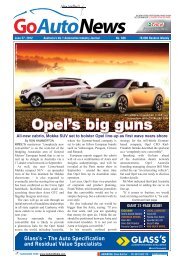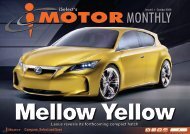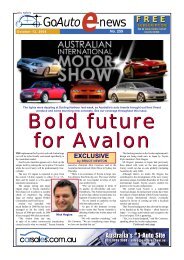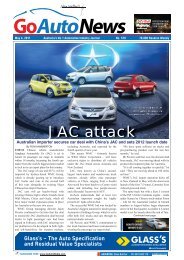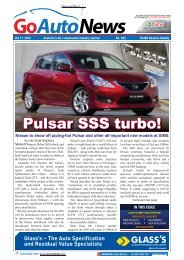GoAutonews
GoAutonews
GoAutonews
Create successful ePaper yourself
Turn your PDF publications into a flip-book with our unique Google optimized e-Paper software.
John Mellor's<br />
GoAuto<br />
By DAVID HASSALL<br />
A WORLD plastics expert believes that<br />
Australian car-makers and parts manufacturers<br />
will need to embrace new technology in order<br />
to meet future fuel consumption and design<br />
requirements.<br />
Sabic Innovative Plastics, a Saudi Arabian<br />
company that last year took over GE Plastics,<br />
has developed a lightweight alternative to<br />
automotive glass as well as a plastic<br />
material that recycles plastic bottles<br />
but does not possess the reduced properties of<br />
regular recycled plastic.<br />
Sabic’s global technical manager for body<br />
panels and glazing Frank Mooijman has told<br />
GoAuto that these new developments would<br />
revolutionise the design and production of<br />
headlights, front fenders, rear quarter windows,<br />
tailgates and panoramic roofs in particular.<br />
A Dutch-based engineer, Mr Mooijman also<br />
previewed a new style of steering wheel made<br />
entirely without metal that could be moulded<br />
into any shape a designer desired. He expects<br />
such injection-moulded steering wheels will<br />
be in production within two years.<br />
Visiting Australia earlier this month,<br />
Mr Mooijman demonstrated Sabic’s latest<br />
developments to OEMs and suppliers,<br />
underscoring the benefits of plastic in terms<br />
of design flexibility and reduced weight.<br />
Half a century ago, GE invented Lexan,<br />
a bulletproof polycarbonate material that<br />
protects the eyes of racing drivers and<br />
motorcyclists around the world, and one of<br />
Sabic’s new products is Lexan glazing that<br />
Mr Mooijman said has “stormed the market”.<br />
Lexan glazing is half the weight of glass<br />
and, although also twice as expensive, would<br />
Green Green issues in the auto world<br />
SUBSCRIBE FREE: www.mellor.net<br />
Green A p r i l 16, 2008 Page 23<br />
Custom Fleet<br />
Part of GE Commercial Finance<br />
GoAuto Green is brought<br />
to you by Custom Fleet<br />
Plastic fantastic<br />
New materials and<br />
technology are changing<br />
the automotive industry<br />
Custom Fleet<br />
Part of GE Commercial Finance<br />
save up to 5kg for a Holden Commodore rear<br />
window.<br />
In the case of a panoramic roof on an SUV<br />
or people-mover, as on the latest Europeanmarket<br />
Opel Zafira, the weight reduces from<br />
about 40kg to 20kg and greatly lowers the<br />
vehicle’s centre of gravity.<br />
“I think fuel consumption pressure will<br />
come here (to Australia), and if that starts<br />
to become a pressure, then look at all the<br />
parts that can save you weight,” said Mr<br />
Mooijman.<br />
“Really, everyone should be looking at<br />
glazing. With the current technology, it’s a<br />
no-brainer. You should look at opportunities<br />
there to take your weight out.”<br />
Sabic has developed defroster technology<br />
to enable Lexan glazing to be used for rear<br />
windows, but it remains too flexible to be<br />
used on wind-up side windows and is not<br />
legally permitted for windscreens, which<br />
must be made of glass.<br />
However, Sabic hopes that legislation will<br />
change in the future and in the meantime is<br />
working on new hard-coating so that plastic<br />
windscreens of the future will be sufficiently<br />
“We listen to your needs.<br />
Then we create tailor-made solutions.”<br />
To find out more, call Custom Fleet, the fleet management experts on 1800 812 681.<br />
Opel Zafira uses lightweight Lexan<br />
material (left) in its modular roof<br />
scratch-resistant to wipers.<br />
Lexan rear glass is being used on four<br />
production models globally, including the<br />
innovative wraparound “extra window” that<br />
brings a unique styling element to the tail of<br />
the British-built Honda Civic hatchback, as<br />
seen on the local-market Civic Type R.<br />
The same material enabled Volkswagenowned<br />
Seat to make its five-door Leon<br />
hatchback look like a two-door coupe by<br />
having a non-glass rear quarter window with a<br />
built-in recessed hand-grip that provides access<br />
to the hidden door handles, so the rear doors<br />
do not have obtrusive handles. The complex<br />
shape exceeded the limitations of glass.<br />
“This is really new,” said Mr Mooijman.<br />
“Trains and trucks are a little further ahead<br />
because the requirements are different to<br />
automotive, where scratch resistance is really<br />
important. So there are only four (cars) on the<br />
market, but many more to come.<br />
“Traditionally, our contact is with<br />
engineers, but we do more and more with<br />
stylists because they drive new developments<br />
in the automotive industry.<br />
Continued next page



